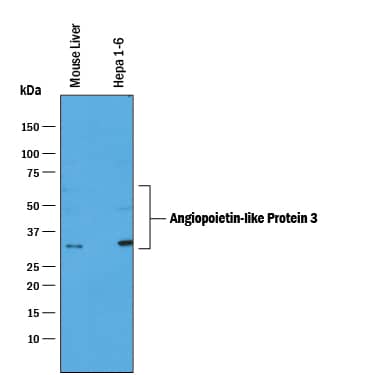Mouse Angiopoietin-like Protein 3/ANGPTL3 Antibody
R&D Systems, part of Bio-Techne | Catalog # AF136


Key Product Details
Species Reactivity
Validated:
Cited:
Applications
Validated:
Cited:
Label
Antibody Source
Product Specifications
Immunogen
Ser17-Thr455
Accession # Q9R182
Specificity
Clonality
Host
Isotype
Scientific Data Images for Mouse Angiopoietin-like Protein 3/ANGPTL3 Antibody
Detection of Mouse Angiopoietin‑like Protein 3/ANGPTL3 by Western Blot.
Western blot shows lysates of mouse liver tissue and Hepa 1-6 mouse hepatoma cell line. PVDF membrane was probed with 0.25 µg/mL of Goat Anti-Mouse Angiopoietin-like Protein 3/ANGPTL3 Antigen Affinity-purified Polyclonal Antibody (Catalog # AF136) followed by HRP-conjugated Anti-Goat IgG Secondary Antibody (Catalog # HAF019). Specific bands were detected for Angiopoietin-like Protein 3/ANGPTL3 at approximately 35 kDa (major band) and 52 & 63 kDa (minor bands, as indicated). This experiment was conducted under reducing conditions and using Immunoblot Buffer Group 1.Angiopoietin-like 3 in Mouse Liver.
Angiopoietin-like 3 was detected in perfusion fixed frozen sections of mouse liver using Goat Anti-Mouse Angiopoietin-like 3 Antigen Affinity-purified Polyclonal Antibody (Catalog # AF136) at 5 µg/mL overnight at 4 °C. Tissue was stained using the Anti-Goat HRP-DAB Cell & Tissue Staining Kit (brown; Catalog # CTS008) and counterstained with hematoxylin (blue). Specific labeling was localized to the cytoplasm of hepatocytes. View our protocol for Chromogenic IHC Staining of Frozen Tissue Sections.Applications for Mouse Angiopoietin-like Protein 3/ANGPTL3 Antibody
Immunohistochemistry
Sample: Immersion fixed paraffin-embedded sections of mouse liver and perfusion fixed frozen sections of mouse liver
Western Blot
Sample: Mouse liver tissue and Hepa 1‑6 mouse hepatoma cell line
Formulation, Preparation, and Storage
Purification
Reconstitution
Formulation
Shipping
Stability & Storage
- 12 months from date of receipt, -20 to -70 °C as supplied.
- 1 month, 2 to 8 °C under sterile conditions after reconstitution.
- 6 months, -20 to -70 °C under sterile conditions after reconstitution.
Background: Angiopoietin-like Protein 3/ANGPTL3
ANGPTL3 is a secreted glycoprotein that is structurally related to the angiopoietins (1‑3). Mature mouse ANGPTL3 contains an N‑terminal coiled‑coil domain and a C‑terminal fibrinogen-like domain (4). ANGPTL3 is expressed in the liver from early in development through adulthood (4, 5). Full length ANGPTL3 circulates in the plasma as do the proteolytically separated N- and C‑terminal fragments containing the coiled-coil domain and fibrinogen-like domains, respectively (6, 7). ANGPTL3 is found as 70 kDa, 50 kDa, and 32 kDa species and can form weakly associated noncovalent multimers in vitro (5, 6). ANGPTL3 directly inhibits lipoprotein lipase (LPL), an enzyme responsible for hydrolyzing circulating triglycerides (8). This activity requires a putative heparin‑binding motif that is N‑terminal to the coiled‑coil domain (6). Proteolytic removal of the fibrinogen-like domain from the N-terminal fragment serves to activate ANGPTL3 and increase its ability to inhibit LPL in vitro and function in vivo (6). ANGPTL3 promotes an increase in circulating triglyceride levels without altering VLDL or HDL secretion or uptake (6‑8). ANGPTL3 knockout mice are hypolipidemic and have elevated LPL activity (9). ANGPTL3 expression in vivo is up‑regulated by LXR agonists and down‑regulated by insulin, leptin, and TR beta agonists (10‑12). Dysregulated ANGPTL3 expression and elevated plasma triglyceride levels are characteristic of some strains of obese and diabetic mice, (7, 8, 11). ANGPTL3 does not bind Tie-1 or Tie-2 but its fibrinogen-like domain interacts with integrin alphaV beta3 to induce endothelial cell adhesion, migration, and neovascularization (13). ANGPTL3, secreted by fetal liver cells, also promotes the expansion of hematopoietic stem cells (14). Mature mouse ANGPTL3 shares 22%‑30% amino acid (aa) sequence identity with ANGPTL1, 2, 4, 6, and 7. It shares 77% aa sequence identity with human ANGPTL3.
References
- Li, C. (2006) Curr. Opin. Lipidol. 17:152.
- Oike, Y. et al. (2004) Int. J. Hematol. 80:21.
- Kersten, S. (2005) Biochem. Soc. Transact. 33:1059.
- Conklin, D. et al. (1999) Genomics 62:477.
- Ge, H. et al. (2005) J. Lipid Res. 46:1484.
- Ono, M. et al. (2003) J. Biol. Chem. 278:41804.
- Koishi, R. et al. (2002) Nat. Genet. 30:151.
- Shimizugawa, T. et al. (2002) J. Biol. Chem. 277:33742.
- Koster, A. et al. (2005) Endocrinology 146:4943.
- Inaba, T. et al. (2003) J. Biol. Chem. 278:21344.
- Shimamura, M. et al. (2004) Biochem. Biophys. Res. Commun. 322:1080.
- Fugier, C. et al. (2006) J. Biol. Chem. 281:11553.
- Camenisch, G. et al. (2002) J. Biol. Chem. 277:17281.
- Zhang, C.C. et al. (2006) Nat. Med. 12:240.
Alternate Names
Gene Symbol
UniProt
Additional Angiopoietin-like Protein 3/ANGPTL3 Products
- All Products for Angiopoietin-like Protein 3/ANGPTL3
- Angiopoietin-like Protein 3/ANGPTL3 cDNA Clones
- Angiopoietin-like Protein 3/ANGPTL3 ELISA Kits
- Angiopoietin-like Protein 3/ANGPTL3 Lysates
- Angiopoietin-like Protein 3/ANGPTL3 Primary Antibodies
- Angiopoietin-like Protein 3/ANGPTL3 Proteins and Enzymes
- Angiopoietin-like Protein 3/ANGPTL3 Simple Plex
Product Documents for Mouse Angiopoietin-like Protein 3/ANGPTL3 Antibody
Product Specific Notices for Mouse Angiopoietin-like Protein 3/ANGPTL3 Antibody
For research use only
